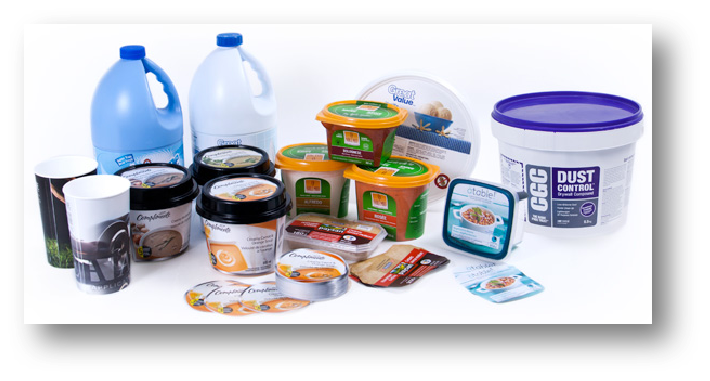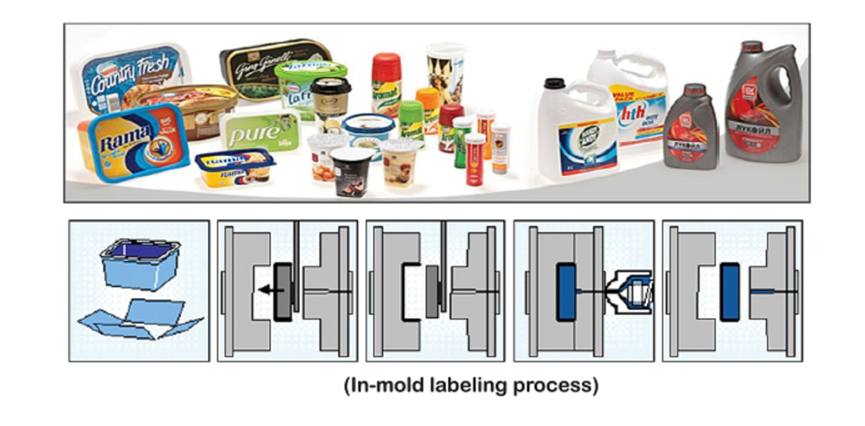In Mould Labelling Technology “IML”
THE IML PROCESS
In-mold labeling, or IML, is an innovative technology that opens new horizons in the labeling process used for all types of injection-molded, blow-molded, and thermoformed plastic containers or parts. The IML process allows you to fuse in-mold labels (high-quality graphic images) to plastic in a single step when molding your plastic containers or parts. Your brand image is permanently protected with durable plastic properties that resist the elements.
Markets Applications
Markets Applications IML technology meets the demands of various markets given its many benefits and qualities, such as permanent, transparent, and waterproof molded labels. Some of these markets include manufacturers of pharmaceutical, cosmetic, household, petrochemical, and paint containers. The IML process also applies to various molded plastic parts designed to improve the impact of your brand at points of sale. The IML process opens a wide door for creativity and is often the ideal solution for custom projects. The advantages of fusing in-mold labels (images) to plastic containers or parts are many, and there are just as many examples of such applications.


History – IML:
-Injection in-mold labeling (injection-IML) pioneered in Europe in the late 1970s
-IML in Europe is a mainstream process used extensively, but not exclusively, for food packaging
-An estimated 85 % to 95 % of rigid food packaging there now uses IML, as do some durable goods such as returnable beer crates.
-IML reportedly started in the U.S. in the early 1980s
-By Procter & Gamble and Owens-Illinois Packaging (now part of Graham Packaging), the first applications were blow-molded HDPE bottles with paper
labels coated with a heat-activated adhesive.
-Problems with label quality, feeding, and handling kept IML activity low-key in the U.S. until the mid-1990s when it was rekindled by molders’ attempts to eliminate secondary operations, reduce the scrap rate from post-mold labeling, and produce a “no-label” look similar to that of blow-molded articles.
IML – Process
- Take the label from the magazine
- Charge electrostatically the label, so that it sticks to the mold wall
- Insert label in the mold
- The hot plastic envelopes the label making it an integral part of the molded item
- Simultaneously remove the finished part and hand over the label

Advantage of IML:
- Elimination of Secondary Processes
- Reduction in Work in Progress
- Reduction in Scrap Rates
- The label becomes an integral part of the product, rather than resting on the outside.
- The label thereby takes on structural as well as decorative value whilst reducing package weight by as much as 10% to 15% while adding also sidewall strength.
- Improvement of sidewall strength of a container up to 120%
- IML improves the ‘BRAND IMAGE’ of the product
- With attractive and colorful packaging the sales increase by 30%
- Add value to product and safety messaging
- Shelf Presence or point of purchase appeal

In-Mold Labelling – vs – In-Mold Decoration
The IMD process requires more complex and more costly technology than does the IML process. It is intended for products that have a longer shelf life, such as cell phones and automotive instrument panels.
The IML process, on the other hand, is intended for products that have an average shelf life. It is less costly to operate and is better suited for high-run production.
It is mainly recommended for food product containers (ice creams, yogurts, sauces, etc.), cosmetic and personal care product containers (creams, foundations, blushes, dyes, shampoo bottles, shower gel bottles, deodorants, etc.), petrochemical and paint containers (solvents, paint, engine oil, etc.), household product containers (laundry detergents, fabric softeners, liquid cleaners, etc.), and other molded plastic parts.
The decorative effect options are numerous and include high-resolution lithographic printing and exceptional color accuracy. The vast assortment of finishes used to enhance the aesthetics and performance of your brand at point-of-sale is equally extensive.
IML Advantages and Benefits
IML VS. SHRINK SLEEVE LABELS
Shrink sleeve labels call for special design software. They also require secondary operations during production. The finished product is, therefore, more expensive to manufacture.
By selecting an in-mold label rather than a shrink sleeve label, you are choosing a product that will save on time and raw materials. The IML process is also an effective means to drastically reduce the amount of waste when launching your production lines.
IML VS. DRY OFFSET
There are many reasons why it is more beneficial to use the IML process rather than the dry offset process. IML uses a simplified production process, thus accelerating changeovers between different batches. This type of labeling also eliminates certain chemicals used by molders in the dry offset process. In addition, in-mold labels provide exceptional print quality, especially with their high-quality images and color consistency. They also provide a much larger print area than those produced with the dry offset process.
What are the benefits of IML food packaging?
The in-mold labeling (IML) enables design flexibility, enhances the product appearance, reduces the investment of secondary operations, increases productivity, and is beneficial to the environment. IML Containers’ in-mold labeling advantages include:
- Superior brand recognition with photographic, visually impressive graphics
- Wrap-around labels creating unique shapes and designs of the final products
- Elimination of the cost of secondary labeling and decorating operations
- Durable surfacing eliminating peeling or curling of the labels caused during transportation
- Maximizing brand visibility by utilizing the space on plastic part on all sides and bottom
- Thin wall plastic part reducing the amount of resin used and shipping cost
- Easy design variations by changing graphics, such as different flavors, in the same run
- Premium printing capability allows high resolution to achieve the extreme of eight PMS color-like result
- Mono-material, #5 Polypropylene, reducing the cost and energy utilized in recycling
- Flexibility and resistance to humidity, heat, cooling, deep freezing, and microwaving
CONCLUSION
IML is one of the fastest-growing markets in the injection molding business, estimated to grow at 6-10% annually for the next several years.
The label industry has now reached the inflection point for moderately high growth on a small base, and with this kind of capacity creation, one can expect a CAGR of at least 19 percent over several years.
There is also the opportunity and the need to aim for 25 percent growth because this industry is still small and because it can be technology and export-driven.
About the Author:
Mohammed Abdul Haleem
Email: packagingprinting@consultant.com
With almost 27 years of experience in the printing industry, he offers proactive recommendations on anilox roll specifications, flexographic printing sleeves, testing, inventory management, flexographic equipment applications, training, representation from experience in technical sales, marketing, production, technical service, parts, and supplies. His experience covers the spectrum of flexographic markets including wide web flexible packaging, narrow web, tag & labels, foil, folding carton, corrugated packaging applications.


